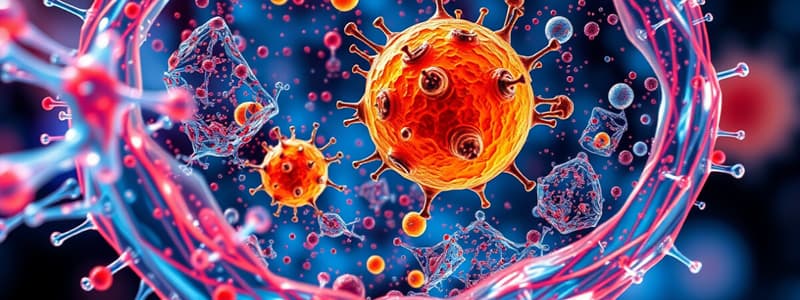Podcast
Questions and Answers
An organism's survival depends on its ability to move needed materials into the cell across the cell membrane and to transport wastes outside the cell across the cell membrane.
An organism's survival depends on its ability to move needed materials into the cell across the cell membrane and to transport wastes outside the cell across the cell membrane.
True (A)
Simple diffusion is defined as the movement of?
Simple diffusion is defined as the movement of?
molecules from areas of higher concentration to areas of lower concentration.
When sugar is mixed with water, equilibrium is reached when?
When sugar is mixed with water, equilibrium is reached when?
the dissolved sugar molecules are evenly distributed throughout the solution.
The rate of diffusion is affected by which of the following?
The rate of diffusion is affected by which of the following?
The molecules in a solid lump of sugar do not move.
The molecules in a solid lump of sugar do not move.
Diffusion is one of the processes whereby materials are exchanged between a cell and its environment.
Diffusion is one of the processes whereby materials are exchanged between a cell and its environment.
Macronutrients are required in ______ quantities and play principal roles in cell structure and metabolism.
Macronutrients are required in ______ quantities and play principal roles in cell structure and metabolism.
Micronutrients are present in ______ amounts and are involved in enzyme function and maintenance of protein structure.
Micronutrients are present in ______ amounts and are involved in enzyme function and maintenance of protein structure.
Nutrition is the process of acquiring the ______ substances needed for cellular activities.
Nutrition is the process of acquiring the ______ substances needed for cellular activities.
Nutrient molecules that contain the basic framework of carbon and hydrogen are called ______ nutrients.
Nutrient molecules that contain the basic framework of carbon and hydrogen are called ______ nutrients.
Which of the following is NOT a characteristic of active transport?
Which of the following is NOT a characteristic of active transport?
Which of the following are examples of membrane transport that do NOT require energy from the cell?
Which of the following are examples of membrane transport that do NOT require energy from the cell?
A 5% urea solution is ______ to a 10% urea solution.
A 5% urea solution is ______ to a 10% urea solution.
Osmosis is best defined as the movement of?
Osmosis is best defined as the movement of?
Which of the following will pass through a cell membrane most easily?
Which of the following will pass through a cell membrane most easily?
A red blood cell placed in a hypertonic medium will?
A red blood cell placed in a hypertonic medium will?
If a cell is placed in an isotonic medium, there will be no net movement of water.
If a cell is placed in an isotonic medium, there will be no net movement of water.
Flashcards are hidden until you start studying
Study Notes
Cell Transportation and Diffusion
- Organisms require the ability to move materials across cell membranes for survival, including waste removal.
- Simple diffusion is the movement of molecules from areas of higher concentration to lower concentration.
- Equilibrium in a solution occurs when particles, such as sugar in water, are evenly distributed.
Factors Affecting Diffusion
- The rate of diffusion is influenced by concentration gradients, the temperature of the environment, and the size of the molecules involved.
- Molecules in a solid, like a lump of sugar, are not stationary; they continually vibrate and move.
Nutrients and Their Roles
- Macronutrients are needed in larger quantities and are crucial for cell structure and metabolism.
- Micronutrients are necessary in smaller amounts for enzyme function and maintaining protein structure.
- Nutrition involves the acquisition of chemical substances essential for cellular processes.
Types of Nutrients
- Nutrients are classified as organic if they contain carbon and hydrogen frameworks.
- Nutrient molecules are vital for cellular metabolism and growth.
Transport Mechanisms
- Active transport requires energy and involves proteins to move molecules against their concentration gradient.
- Passive transport processes, which do not require energy, include diffusion, osmosis, and facilitated diffusion.
Water Movement and Cell Behavior
- Osmosis is defined as the movement of water molecules from areas of high concentration to low concentration across a membrane.
- Small nonpolar molecules pass through cell membranes most easily due to their size and polarity.
- A red blood cell in a hypertonic solution will lose water and shrink.
- Solutions are categorized: a 5% urea solution is hypotonic compared to a 10% urea solution, affecting cell behavior.
Isotonic Solutions
- In isotonic conditions, there is no net movement of water, maintaining cell stability without shrinking or swelling.
Studying That Suits You
Use AI to generate personalized quizzes and flashcards to suit your learning preferences.



